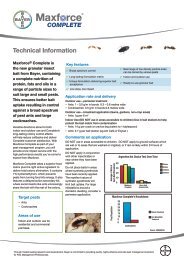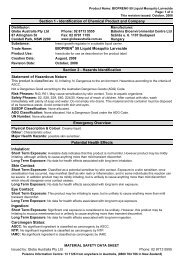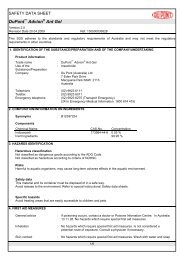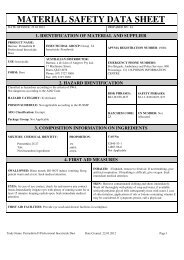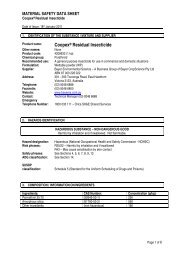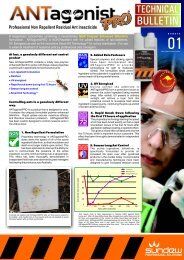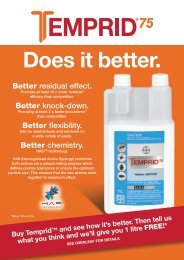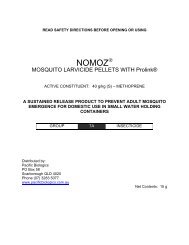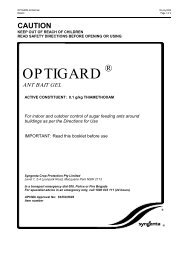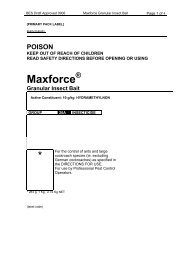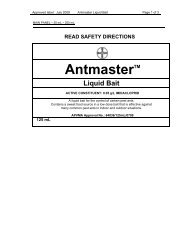Chaindrite Aerosol Spray MSDS - Knock-Out Pest Control
Chaindrite Aerosol Spray MSDS - Knock-Out Pest Control
Chaindrite Aerosol Spray MSDS - Knock-Out Pest Control
Create successful ePaper yourself
Turn your PDF publications into a flip-book with our unique Google optimized e-Paper software.
<strong>MSDS</strong> – <strong>Chaindrite</strong> Extra-Strength Crawling Insect <strong>Spray</strong><br />
Section 3: Composition / Information on Ingredients<br />
Chemical entity CAS N o Proportion<br />
Imiprothrin 72963-72-5 0 – 1%<br />
Cypermethrin 52315-07-8 0 – 1%<br />
Solvent naphtha (petroleum) medium<br />
64742-88-7 10 – 30%<br />
aliphatic<br />
Ethanol 64-17-5 30 30 – 60%<br />
Hydrocarbon propellant<br />
- Propane<br />
- Butane<br />
74-98-6<br />
106-97-8<br />
30 – 60%<br />
Other ingredients to 100%<br />
Section 4: First Aid Measures<br />
FIRST AID:<br />
For advice, contact a Poisons Information Centre, Phone Australia 13 1126; New Zealand 0800 764<br />
766, or a doctor at once.<br />
Inhalation: Do not breathe vapour/ spray. Remove victim to fresh air. Keep victim warm and calm.<br />
If patient is unconscious and breathing, place them in the coma position, check airway and observe.<br />
Administer oxygen if breathing is difficult. Apply resuscitation if victim is not breathing. Obtain<br />
immediate medical care.<br />
Skin: May irritate skin. Avoid contact with skin. If skin or hair contact occurs, remove<br />
contaminated clothing and flush skin and hair immediately with running water at room temperature<br />
for 15 minutes.<br />
Eye: May irritate eyes. If in eyes wash out immediately with water for 15 minutes. Obtain medical<br />
care.<br />
Ingestion: Due to high volatility of product, this is not likely to occur. If sprayed in mouth, rinse<br />
mouth with water. If swallowed, do not induce vomiting: seek medical advice immediately and<br />
show this container or label.<br />
ADVICE TO DOCTOR -<br />
Treat symptomatically<br />
Section 5: Fire Fighting Measures<br />
Fire/Explosion Hazard:<br />
Extinguishing Media<br />
Small fire: Use water spray, dry chemical or carbon dioxide.<br />
Large fire: Use water spray or fog.<br />
Fight fire from protected position or use unmanned hose holders or monitor<br />
nozzles. If safe to do so, move undamaged containers from fire area. Do not<br />
approach hot containers. Cool containers with water before handling. If<br />
impossible to extinguish fire, protect surroundings, withdraw from are and<br />
allow fire to burn.<br />
Hazards Heat or damage to containers can release flammable / poisonous gases.<br />
Extremely flammable. Pressurised dispenser. Closed containers may rupture<br />
when exposed to heat greater than 50 C. Ruptured containers will rocket.<br />
Released gases can form explosive mixtures with air. Hazardous<br />
concentrations can accumulate in a confined space. Released gases can travel



